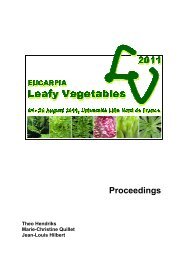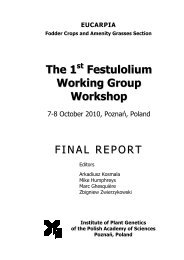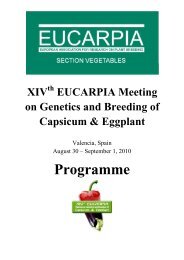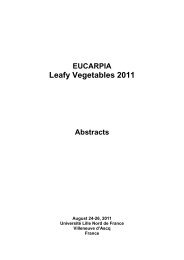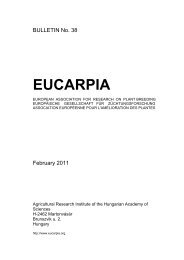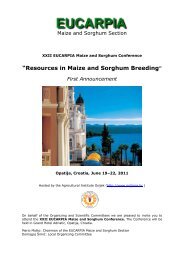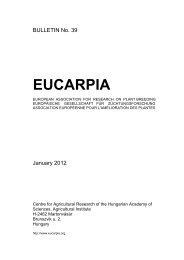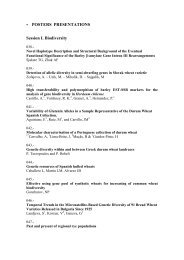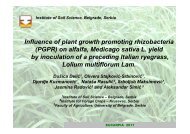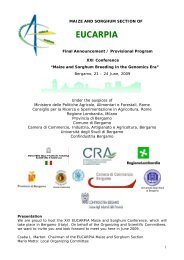Plant breeding for organic and sustainable, low-input agriculture
Plant breeding for organic and sustainable, low-input agriculture
Plant breeding for organic and sustainable, low-input agriculture
You also want an ePaper? Increase the reach of your titles
YUMPU automatically turns print PDFs into web optimized ePapers that Google loves.
Identification of the components of several cultivar mixtures in Spanish wheat by means of<br />
SSR markers<br />
Fern<strong>and</strong>o Martínez, Mar Cátedra, Pilar Rallo<br />
Dpto. Ciencias Agro<strong>for</strong>estales, EUITA, University of Seville, Spain<br />
Cultivar mixture is one of the proposed solutions to increase genetic diversity within a crop,<br />
which is one of the major issues in the <strong>organic</strong> farming. Several positive effects have been<br />
reported on cultivar mixtures, being the reduction of foliar diseases the main cited effect in the<br />
literature. It reduces also the risk of resistance gene break-down again these diseases. Abiotic<br />
stresses are also better buffered than in pure st<strong>and</strong>s, yield stability increases <strong>and</strong> even quality of<br />
the product can be enhanced (Finck et al., 2001).<br />
This work aims at differentiating the pure st<strong>and</strong>s within a mixture in order to overcome legal<br />
problems in dealing with genetic diversity in the seed market.<br />
In this work, four cultivar mixtures of bread wheat <strong>and</strong> four of durum wheat have been designed<br />
<strong>for</strong> improving disease resistance, production <strong>and</strong> quality. All the cultivar mixtures were fourway,<br />
i.e. composed by four cultivars. Mixtures were picked from the field (be<strong>for</strong>e f<strong>low</strong>ering),<br />
where 25 sample leaves were collected in order to be sure (99% probability) of getting at least<br />
one leaf of each cultivar. Besides, mixtures were also collected from the greenhouse, where one<br />
leaf of each cultivar was collected to create the mixture with certainty.<br />
Five SSR markers or microsatellites were used (BARC109, BARC176, Xgwm448, DuPw67 <strong>and</strong><br />
DuPw254). The microsatellite DuPw167 <strong>and</strong> BARC176 were the most suitable <strong>for</strong> the<br />
discrimination of cultivar mixtures in bread <strong>and</strong> durum wheat (Röder et al., 2002). They showed<br />
a fair level of polymorphism. It is remarkable that, sometimes, differences in the amplification<br />
within a mixture have been detected. That means that some alleles are better amplified than<br />
others. This may suggest a competence of the alleles within the mixture to be amplified, which is<br />
not desirable at all but it has been reported (Rallo et al., 2001).<br />
In general, the level of polymorphism detected in durum wheat was higher than in bread wheat.<br />
60




